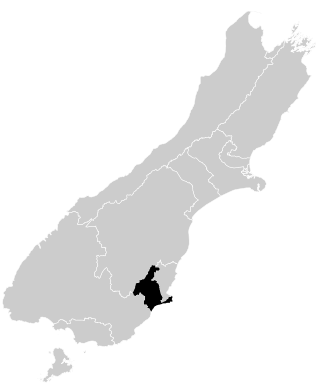Related Research Articles
William Henry Cutten was a New Zealand politician from the Otago region.

Sir Thomas Kay Sidey was a New Zealand politician from the Otago region, remembered for his successful advocacy of daylight saving time.

Dunedin South is a former New Zealand parliamentary electorate. It first existed from 1881 to 1890, and subsequently from 1905 to 1946. In 1996, the electorate was re-established for the introduction of MMP, before being abolished in 2020.
Peninsula was an Otago electorate in the New Zealand Parliament from 1881 to 1893, based on the Otago Peninsula.
Caversham was a parliamentary electorate in the city of Dunedin in the Otago region of New Zealand, from 1866 to 1908.
Taieri is a parliamentary electorate in the Otago region of New Zealand, initially from 1866 to 1911, and was later recreated during the 2019/20 electoral redistribution ahead of the 2020 election.
Waikouaiti was a parliamentary electorate in the Otago region of New Zealand, from 1866 to 1908.
Dunedin Country was a parliamentary electorate in the rural area surrounding the city of Dunedin in Otago, New Zealand, from 1853 to 1860. It was a two-member electorate and was represented by a total of five members of parliament.
Dunedin and Suburbs South was a parliamentary electorate in the city of Dunedin in Otago, New Zealand from 1862 to 1866. From 1863 it was a multi-member electorate.
The 4th New Zealand Parliament was a term of the Parliament of New Zealand.
James McIndoe was a 19th-century Member of Parliament from Dunedin, New Zealand.
Richard Seaward Cantrell was a 19th-century Member of Parliament from Dunedin, New Zealand.
The 5th New Zealand Parliament was a term of the New Zealand Parliament. Elections for this term were held in 68 European electorates between 14 January and 23 February 1871. Elections in the four Māori electorates were held on 1 and 15 January 1871. A total of 78 MPs were elected. Parliament was prorogued in December 1875. During the term of this Parliament, six Ministries were in power.
The Otago Witness was a prominent illustrated weekly newspaper in the early years of the European settlement of New Zealand, produced in Dunedin, the provincial capital of Otago. Published weekly, it existed from 1851 to 1932. The introduction of the Otago Daily Times, followed by other daily newspapers in its circulation area, led it to focus on serving a rural readership in the lower South Island, where poor road access prevented newspapers being delivered daily. It also provided an outlet for local fiction writers. It is notable as the first newspaper to use illustrations and photographs and was the first New Zealand newspaper to provide a correspondence column for children, which was known as "Dot's Little Folk". Together with the Auckland-based Weekly News and the Wellington-based New Zealand Free Lance it was one of the most significant illustrated weekly New Zealand newspapers in the 19th and early 20th centuries.
Edward Thomas Gillon was a New Zealand journalist and newspaper editor.

The Dunedin Country by-election 1858 was a by-election held in the multi-member Dunedin Country electorate during the 2nd New Zealand Parliament, on 16 June 1858. The by-election was caused by the resignation of incumbent MP John Cargill and was won by John Taylor.
The Bruce by-election 1862 was a by-election held in the multi-member Bruce electorate during the 3rd New Zealand Parliament, on 31 July 1862. The by-election was caused by the death of incumbent MP Charles Kettle on 5 June, and was won by Edward Cargill.
The 1875 Caversham by-election was a by-election held on 20 August 1875 during the 5th New Zealand Parliament in the Caversham electorate in the south-east of the South Island.
The April 1865 Bruce by-election was a New Zealand by-election held in the multi-member electorate of Bruce during the 3rd New Zealand Parliament on 8 April 1865. It was triggered on 9 January that year by the resignation of separationist Thomas Gillies and won by prominent settler Arthur John Burns. The more liberal businessman William John Dyer was the sole other contester of the by-election, finishing with 43.33% of the vote.
The 1870 Caversham by-election was a by-election held on 25 April 1870 in the Caversham electorate in the Otago region of New Zealand during the 4th New Zealand Parliament.
References
- ↑ Wilson, James Oakley (1985) [First ed. published 1913]. New Zealand Parliamentary Record, 1840–1984 (4th ed.). Wellington: V.R. Ward, Govt. Printer. p. 188. OCLC 154283103.
- ↑ "Caversham Election". Otago Witness . No. 1082. 24 August 1872. p. 16. Retrieved 22 January 2019– via Papers Past.
- ↑ "The Caversham Election". Otago Witness . No. 1083. 31 August 1872. p. 11.
- ↑ "Dunedin". The Cromwell Argus . Vol. III, no. 146. 27 August 1872. p. 5.
- 1 2 "Caversham Election". Evening Star . No. 2975. 31 August 1872. p. 2. Retrieved 22 January 2019.